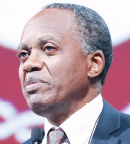
Leon Tshilolo, MD, PhD, discusses the plenary abstract on improving sickle cell disease outcomes in the United States and Africa. Photo by © ASH/Todd Buchanan 2018.
THE LARGEST PROSPECTIVE trial of hydroxyurea for sickle cell anemia has shown that this treatment is feasible, accepted, well tolerated, and safe for children living in sub-Saharan Africa. Hydroxyurea has long been the standard of care for treating children with sickle cell anemia in developed countries. Leon Tshilolo, MD, PhD, of the Centre Hospitalier Monkole in Kinshasa, Democratic Republic of the Congo, reported that there are distinct clinical benefits for children receiving hydroxyurea during the Plenary Session at the 2018 American Society of Hematology (ASH) Annual Meeting & Exposition.1
After a median of 2.5 years of treatment, children in the trial experienced less pain and anemia, fewer episodes of malaria and other infections, and lower rates of transfusions and death compared with rates during the pretreatment screening phase of the trial.
“Because of its positive impact on anemia, clinical events, and quality of life, hydroxyurea can now be considered for routine care of children with sickle cell anemia in Africa,” Dr. Tshilolo said in a news release from ASH. Previous studies had suggested hydroxyurea treatment might put children at higher risk for malaria by suppressing the immune system, but this was not the case in the current study. “We’re very encouraged by the fact that we saw reductions in the rates of malaria and other infections,” he said. “This suggests that hydroxyurea doesn’t cause suppression of the immune system in treated children and therefore doesn’t increase their risk for malaria or other infectious diseases.”
Ample data support the value of hydroxyurea treatment for children with sickle cell anemia who live in high-resource countries such as the United States, the United Kingdom, and European countries, Dr. Tshilolo said. However, prior to this study, data were lacking on the drug’s benefi ts for children living in sub-Saharan Africa, where the burden of sickle cell anemia is highest and the rates of malaria and other infectious diseases, as well as undernutrition and poverty, are extremely high.
Study Methods
A TOTAL OF 635 children between the ages of 1 and 10 (median age at enrollment = 5.4 years) from Angola, the Democratic Republic of the Congo, Kenya, and Uganda were enrolled in the trial. Four children died during a 2-month screening period before treatment began; 25 other children withdrew from the trial for other reasons during the screening period.
The remaining 606 children began 6 months of hydroxyurea treatment at an average dose of 17.5 ± 1.8 mg/kg/d. After 6 months, if no adverse eff ects were observed, the dose was escalated by 2.5 to 5.0 mg/kg/d every 8 weeks until mild marrow suppression, typically indicated by an absolute neutrophil count < 4.0 x 109/L, or absolute reticulocyte count < 150 x 109/L based on weight and other criteria, to a maximum tolerated dose.
Key Findings
A TOTAL OF 515 participants (85%) achieved the maximum tolerated dose at an average dose of 22.5 ± 4.9 mg/kg/d; the average time to maximum dose was 11 months from treatment initiation.
The benefits of hydroxyurea included clinically significant increases in hemoglobin concentration, mean corpuscular volume, and fetal hemoglobin as well as significant decreases in white blood cell count, neutrophils, reticulocytes, rates of vasoocclusive pain, acute chest syndrome, and transfusions. Rates of all-cause mortality decreased from 3.6 deaths per 100 patient-years during screening to 1.1 deaths per 100 patient-years with hydroxyurea.
The investigators reported that 5% of treated patients dropped out of the trial or died. Of those remaining, 97% completed all scheduled study visits, and 94% completed all the required laboratory tests. The rate of toxicities was similar between the screening period and the treatment phase.
Next Steps
DR. TSHILOLO and his colleagues plan to continue to follow the children in this study for several years to observe the effects of hydroxyurea treatment on their growth and sexual development, as well as on the function of organs such as the brain, liver, spleen, and kidneys, and the children’s intellectual performance as they get older.
The cost of hydroxyurea treatment and associated laboratory monitoring will be a major factor limiting more widespread use of the drug to treat sickle cell anemia in Africa. “The current cost of treatment is beyond the daily wage of most families living in sub-Saharan Africa,” Dr. Tshilolo said. “We hope that treatment will be made available to more patients through outside financial support.” ■
DISCLOSURE: Dr. Tshilolo reported no conflicts of interest. Full disclosures for all of the study authors is available at https://ash.confex.com/ash/2018/webprogram/Paper113818.html.
REFERENCE
1. Tshilolo L, Tomlinson G, Williams TN, et al: Realizing effectiveness across continents with hydroxyurea (REACH). 2018 ASH Annual Meeting & Exposition. Abstract 3. Presented December 2, 2018.

